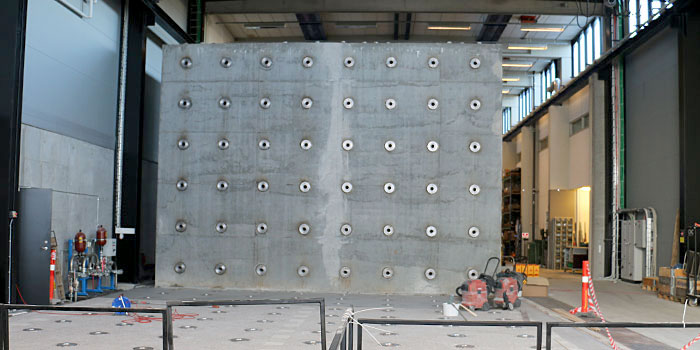Today sees the inauguration of DTU’s new centre for advanced structural and material testing.
When building a bridge or installing a wind turbine, it is important that the materials used in the structures are thoroughly tested, allowing users to move safely on and around them. The new Villum Center for Advanced Structural and Material Testing (CASMaT) pools DTU’s competences within experimental mechanics, and houses several newly built and unique research facilities.
On Lyngby Campus, the centre will offer new opportunities for research into building structures and materials on multiple scales. On Risø Campus, the newly constructed Large Scale Facility will be used for testing large structures such as wind turbine blades.
“The grant from Villum Fonden has given DTU the opportunity to establish new and unique facilities for testing materials and structures from micro-level over sections of building structures to full scale. This offers the opportunity to gain a more fundamental understanding of how different materials and structures behave, and thus optimize the structure and application of them,” says Henrik Stang, Head of CASMaT.

A large strongfloor and strongwall is the foundation for advanced hybrid testing of components and structures at the Structural Lab in Building 119A on Lyngby Campus. Photo: Sabina Askholm Larsen
Structural Lab on Lyngby Campus
The new Building 119A on Lyngby Campus houses a test centre—Structural Lab—which opens up for innovative possibilities for multi-scale research within building construction and materials at the three university departments DTU Civil Engineering, DTU Mechanical Engineering, and DTU Wind Energy.
The new 420 m2 hall contains a strong floor and strong wall, and several technical facilities such as a substation, a hydraulics facility, and a refrigeration system.

Large Scale Facility on Risø Campus. Photo: Bax Lindhardt
Large Scale Facility on Risø Campus
The Large Scale Facililty on Risø Campus is designed for testing major structures, such as wind turbine blades.
"In order to carry out tests on multiple scales, it is necessary to build large-scale facilities to accommodate large scales and at the same time invest in equipment that enables advanced measurements."
Anders O. Bjarklev, President of DTU
With a surface area of 59 x 27 metres and a height of 13 metres, the Large Scale Facility holds three test stands in different sizes where up to 49-metre long wind turbine blades (used for medium-sized wind turbines) can be pulled and twisted in any direction. The picture shows the two largest—the third test stand is concealed behind the control room on the right. When a blade is to be tested, it is bolted onto a metal plate and secured to the test stand. The test equipment, which will pull the blade down towards the floor until it breaks, is secured to the rails in the floor. The force is generated by five hydraulic pumps which create an oil pressure that flows along tubes to distribution blocks located around the hall.
The pull test shows the degree of bending the blade can withstand. The test can end with an almighty bang and a cloud of dust and fragments from the broken blade, which is why the control room is located at a safe distance behind unbreakable glass. The blades will also undergo fatigue testing, which involves subjecting them to repeated vertical and horizontal swinging movements. Although the two tests are normally separate procedures, the equipment allows the blade to be moved in multiple directions at the same time—which is closer to the effect of natural loads.
The first project to use the facility is ‘Blatigue’, a four-year project which seeks to improve the way wind turbine blades are tested. The current fatigue testing of wind turbine blades is not realistic. New research and development is therefore needed,” explains Kim Branner, senior scientist at DTU Wind Energy:
“There is a challenge with the current fatigue tests which do not represent the real world very well, as they only expose wind turbine blades to loads in one direction at a time. In reality, they are subjected to loads in various directions simultaneously. The current tests do not take this into account,” he says and continues:
“We expect that this research will quickly secure us a world-leading position in the field.”
CASMaT is destined to become of the world’s leading facilities for experimental multi-scale research within building construction and materials, and has become a reality, among other things, thanks to a very generous grant from Villum Fonden of EUR 10 million.
“Villum Fonden supports the new facilities at DTU, because we want to contribute to creating the best possible conditions for experimental research in materials and structures in several scales. With these ultra-modern facilities, we now have unique opportunities to conduct research at the very highest international level. It is now up to DTU to ensure that this interdisciplinary potential can be realized. We look forward to monitoring the projects and findings which the centre will help create,” says Lars Hansen, CEO of Villum Fonden.